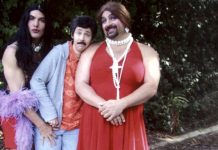You may not know their names or even their faces, but if you watch TV, go to the movies, or play video games, you know their work. Female Stuntwomen have been making on-screen magic happen for decades, masterminding and performing the car chases, bare-knuckle brawls, and wirework that take your breath away. And they’re doing almost all of it under the radar. To find out what it’s like to be female stunt performers now — and what it was like to be female stunt performers when women were first allowed in the roles — Bustle went straight to the source, interviewing five stuntwomen whose tenure in the industry ranges from a few years to four decades.
How They Got Started
Diane Peterson was working as an actor on the set of the ‘70s crime series Kojak when she saw a car chase being filmed and was bitten by the bug. “I went over to the stuntmen when they were done, and I said, ‘I’d like to be a stuntwoman. I ride horses and motorcycles and I race my car in quarter-mile drags,’” she remembers. “And they said, ‘Forget it, honey, we put the wigs on and we do it.’” Yet Peterson kept knocking on the door, offering herself as a double and challenging the assumption that women weren’t as qualified stunt performers as men. And once she proved herself, she says, the male stunt performers eventually considered her to be “in the club.”
On the other hand, Sharon Schaffer’s entry into the business was a little more happenstance. “I was just a wandering, aimless person failing at being a college student,” she says, recalling how she dropped by a family friend’s training gym one day in the late ’80s, just to say hello. And things escalated from there. Soon, she found she had the skills stunt coordinators were looking for, and was landing work in movies like The Blues Brothers and Scarface.
“Black women just didn’t have those kind of backgrounds, they just didn’t have that kind of exposure growing up,” Schaffer says, adding that she believes she was only the third black female stunt performer in the business at the time. “Next thing I knew I was being hand carried to Universal for my first job.”
On Discrimination In Stunts
Both Schaffer and Peterson believe that the stunt business has changed dramatically in the decades they’ve been working, but seem to have different takes on whether it’s progressed or regressed. Peterson, for instance, believes that “wigging,” the practice of having male stunt performers double female characters, is mostly a thing of the past. “Things have gotten really remarkably better,” she says, referring to the time that she’s been in the business. “And I don’t think any man would dare put a wig on, especially if they’re in LA to double a woman.” Schaffer, however, sees it as an ongoing — and even worsening — problem. “It’s very demoralizing,” she says of discrimination in stunts. “It can be very depressing dealing with some of this racism and sexism.”
By Sage Young


























